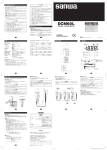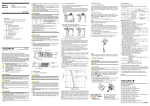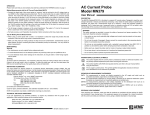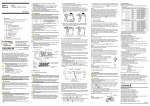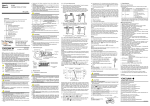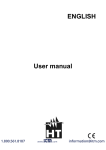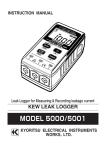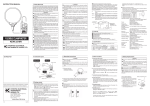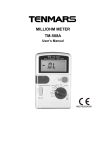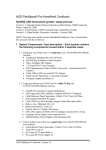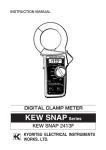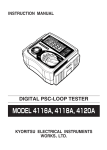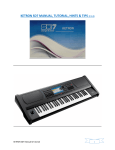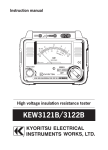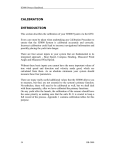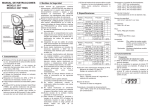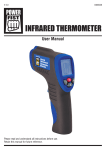Download Instruction Manual
Transcript
INSTRUCTION MANUAL LEAKAGE CURRENT TESTER KEW SNAP Series MODEL 2434 KYORITSU ELECTRICAL INSTRUMENTS WORKS, LTD., TOKYO, JAPAN 1. SAFETY WARNINGS This instrument has been designed and tested according to IEC Publication 61010: Safety Requirements for Electronic Measuring Apparatus. This instruction manual contains warnings and safety rules which must be observed by the user to ensure safe operation of the instrument and to retain it in safe condition. Therefore, read through these operating instructions before starting using the instrument. WARNING ●Read through and understand instructions contained in this manual before starting using the instrument. ●Save and keep the manual at hand to enable quick reference whenever necessary. ●Be sure to use the instrument only in its intended applications and to follow measurement procedures described in the manual. ●Be sure to understand and follow all safety instructions contained in the manual. Not following the above instructions may cause injury, instrument damage and/or damage to equipment under test. The symbol indicated on the instrument means that the user must refer to related parts of the manual for safe operation of the instrument. Be sure to carefully read the instructions following each symbol in this manual. DANGER is reserved for conditions and actions that are likely to cause serious or fatal injury. WARNING is reserved for conditions and actions that can cause serious or fatal Injury. CAUTION is reserved for conditions and actions that can cause minor injury or Instrument damage. DANGER ●Never make measurement on a circuit having potential of 300VAC or greater. ●Do not attempt to make measurement in the presence of flammable gasses. Otherwise, the use of the instrument may cause sparking, which leads to an explosion. ●The transformer jaws are made of metal and their tips are not completely insulated. Be especially careful about the possible shorting where the equipment under test has exposed metal parts. ●Never attempt to use the instrument if its surface or your hand is wet. ●D o n o t e x c e e d t h e m a x i m u m a l l o w a b l e i n p u t o f a n y measurement range. ●Never open the battery compartment cover when making measurement. WARNING ●Never attempt to make any measurement, if any abnormal conditions are noted, such as broken case, cracked test leads and exposed metal parts. ●Do not install substitute parts or make any modification to the instrument. Return the instrument to Kyoritsu or your distributor for repair or re-calibration. CAUTION ●Make sure that the range selector switch is set to an appropriate position before making measurement. ●Do not expose the instrument to the direct sun, extreme temperatures or dew fall. ●Be sure to set the range selector switch to the "OFF" position after use. When the instrument will not be in use for a long period of time, place it in storage after removing the batteries. ●Use a damp cloth and detergent for cleaning the instrument. Do not use abrasives or solvents. ●Always switch off the instrument before opening the battery compartment cover for battery replacement. 2. FEATURES ●Digital clamp tester for AC leakage current measurement. ●Least affected by external magnetic field, providing wide measuring range from very small to large currents. ●Designed to safety standard IEC 61010-2-032: over-voltage CAT.Ⅲ, 300V and pollution degree 2. ●Data hold function to allow for easy readings in dimly lit or hard-toreach locations. ●Provides filtering function to remove high frequency generated by such equipment as inverters. ●Sleep function prevents unnecessary power consumption. ●Dynamic range of 4000 counts full scale. ●Large easy-to-read LCD display with letter height of 13mm. ●Transformer jaws fitted with guard to further improve safety. 3. SPECIFICATIONS Measuring ranges and accuracy Range Measuring Range Accuracy (Frequency range) 400mA 0∼399.9mA ±2.0%rdg±4dgt(50/60Hz) 4A 0∼3.999A ±3.0%rdg±5dgt(40∼400Hz) 100A 0∼100.0A When measuring current which pulse element is superposed, differences of the indicated value may be caused between ranges, if the peak value exceeds the measurement range to a large extent. In this case, the reading at the bigger range should be taken as a right value. Sensitive transformer jaws are used for Leakage clamp meter. Because of the characteristics of transformer jaws, which can be opened and closed, it is impossible to eliminate the interference of external magnetic field completely. If there are something, which generating large magnetic field, at a nearby site, current value can be displayed (“0” cannot be displayed.) before clamping on the conductor. For such a case, please use the instrument at a location far from the thing, which generating magnetic field. Following are the typical things generating magnetic field. Conductor fed large current, Motor, Equipment which has magnet, Integrating wattmeter Measuring method: Display: Low battery warning: Overrange Indication: Response Time: Sample Rate: Accuracy-insured Temperature and Humidity Ranges: Operating Temperature and Humidity Ranges: Storage Temperature and Humidity Ranges: Power Source: Current Consumption: Measurement Time: Sleep Function: Safety Standard: Overload Protection: Withstand Voltage: Insulation Resistance: Conductor Size: Dimensions: Weight: Accessories: Optional Accessories: Dual Integration Liquid crystal display with maximum reading of 3999 "BATT" mark appears on the display "OL" appears on the display when upper limit of measuring range is exceeded Approx. 2 seconds Approx. 2.5 times per second 23℃±5℃, relative humidity 85% or less (without condensation) 0-40℃, relative humidity 85% or less (without condensation) -20-60℃, relative humidity 85% or less (without condensation) Two 1.5V R03 (UM-4) batteries Approx. 4mA Approx. 150 hours Automatically powered down in about 10 minutes after the last switch operation IEC 61010-1, IEC 61010-2-032 over-voltage CAT.Ⅲ 300V, pollution degree 2 IEC 61326 (EMC) 120Arms max. for 10 seconds 3700Vrms (50/60Hz) for 1 minute between metal part of transformer jaws and housing case (except transformer jaw case) 10MΩ or greater at 1000V between metal part of transformer jaws and housing case (except transformer jaw case) Approx. 28mm in diameter max. 169(L)×75(W)×40(D)mm Approx. 220g including batteries Two R03 (UM-4) batteries Carrying case Model 9052 Instruction manual Multi-Tran Model 8004 and 8008 4. INSTRUMENT LAYOUT T r i gger T r a ns f or m J aw s R ange S e le cto r S witch Ha n d S tra p Disp la y ●LCD Low Battery Warning Data Hold Button Frequency Selector Button Data Hold Indication Frequency Response : Wide Frequency Response : 50/60Hz Unit 5. PREPARATIONS FOR MEASUREMENT 5-1 Checking Battery Voltage Set the Range Selector Switch to any position other than the OFF position. If the marks on the display is clearly visible without "BATT" mark showing, battery voltage is OK. If the display blanks or "BATT" is indicated, replace the batteries according to section 8: Battery Replacement. NOTE When the instrument is left powered on, the Sleep function automatically shut the power off; The display blanks even if the Range Selector Switch is set to a position other than the OFF position in this state. To power on the instrument, turn the Range Selector Switch or press any button. If the display still blanks, the batteries are completely exhausted. Replace the batteries. 5-2 Checking Switch Setting Make sure that the Range Selector Switch is set to the appropriate range. Also make sure that data hold function is not enabled. If inappropriate range is selected, desired measurement cannot be made. 6. OPERATING INSTRUCTIONS DANGER ●In order to avoid possible shock hazard, never make measurement on circuits having a potential of 300VAC or greater. ●The transformer jaws are made of metal and their tips are not completely insulated. Be especially careful about the possible shorting where the equipment under test has exposed metal parts. ●Never make measurement with the battery compartment cover removed. CAUTION ●Take sufficient care to not to apply shock, vibration or excessive force to the jaw tips. Otherwise, precisely adjusted Transformer Jaw tips will be damaged. ●When a foreign substance is stuck in the jaw tips or they cannot properly engage, the transformer jaws do not fully close. In such a case, do not release the jaw trigger abruptly or attempt to close the transformer jaws by applying external force. Make sure that the jaws close by themselves after removing the foreign substance or making them free to move. ●The maximum size of a conductor to be tested is 28mm in diameter. Accurate measurement cannot be made on a conductor larger than this, because the transformer jaws cannot fully close. ●When measuring large current, the transformer jaws may buzz. This has no effect on the instrument's performance or safety. 6-1 Leakage Current Measurement (1)Set the Range Selector Switch to the desired position. Current to measure should be within the selected measuring range. (2)Measuring out of balance leakage current (See Fig.1): Clamp onto all conductors except a grounded wire. Measured current value is shown on the display. (3)Measuring earth leakage current (See Fig.2): Clamp onto a grounded wire.Measured current value is shown on the display. Load Load 3-phase 3-wire system (In 4-wire system with neutral, clamp onto all 4 wires) Single-phase 2-wire system (in 3-wire system with neutral, clamp onto all 3 wires) Fig. 1 Measuring out of balance leakage current Load Grounded wire Fig.2 Measuring earth leakage current 6-2 How to Use Frequency Selector Button When high frequencies from such equipment as inverters are present in the circuit under test, the instrument measures AC current of not only 50Hz or 60Hz of fundamental frequency but also of these high frequencies and harmonics. To eliminate the effect of such high frequency noise and measure AC current of 50Hz or 60Hz fundamental frequency, a "high-cut" filter circuit in incorporated into the instrument which works when "50/60Hz" frequency response is selected with the Frequency Selector Button. Cut-off frequency of the "high-cut" filter is about 160Hz with attenuation characteristic of approx. -24dB/octave. When the Frequency Selector Button is pressed, "50/60Hz" mark is shown on the left side of the display. When the Frequency Selector Button is pressed again, frequency response is switched to WIDE with "WIDE" mark shown on the display. Output characteristic are shown in Fig.3. Typical characteristic: 400mA/4A Range 0 Typical characteristic: 100A Range ー10 ー20 ー30 10 20 50 Typical characteristic: “WIDE”frequency response ;;;; ;;;; ;;;; ;;;; ;;;; ;;;; ;;;; 100% Typical characteristic: 50% “50/60Hz”frequency response high-cut filter -24dB/oct 20% 10% Percentage Attenuation〔dB〕 10 5% 100 200 500 1k Frequency〔Hz〕 2k 5k Fig.3 Model 2434 Frequency Characteristic Note: Characteristic of -24dB/octiave means that signal magnitude declines to about one sixteenth of that at the initial frequency when frequency doubles. Model 2434 have the following two settings for the Frequency Selector Button. WIDE (40Hz-): Permits measurement of currents of fundamental frequencies as well as currents of high frequencies generated by such equipment as inverters 50/60Hz (40-approx.160Hz): Filters out high frequency currents and measures current of fundamental frequency only Recently there has been increased use of power through inverters, switching regulators, etc. When the high frequency noise from such appliances leaks or flows into the ground through capacitors not filtering completely, the earth leakage breaker may trip even though there is no "actual" leakage. In such a case, the instrument do not give leakage current reading if "50/60Hz" frequency response is selected. Take current readings with the 50/60Hz and WIDE frequency responses respectively to make effective use of the Frequency Selector Button. 6-3 Load Current Measurement (1)Set the Range Selector Switch to the desired position. Current to measure should be within the selected measuring range. (2)Measuring load current (See Fig.4): Press the jaw trigger to open the transformer jaws and close them over one conductor only.Measured current value is shown on the display. Load Fig.4 Measuring load current 7. OTHER FUNCTIONS 7-1 Sleep Function This is a function to prevent the instrument from being left powered on in order to conserve battery life. The instrument automatically enters the Sleep (powered-down) Mode about 10 minutes after the last switch operation. To exit the Sleep Mode, press the Data Hold or Frequency Selector Button or turn the Range Selector Switch to OFF, then to any other position. How to Exit the Sleep Mode: Turn the Range Selector Switch from “OFF” to another position with the Data Hold Button pressed. Then, “P.OFF” is shown on the display. This disables the Sleep function and enables continuous use of the instrument. To enable the Sleep function, turn the Range Selector Switch back to “OFF”, then to any other position. Note: The instrument consumes small amount of current in the Sleep Mode. When the instrument is not in use, make sure to set the Range Selector Switch to “OFF”. 7-2 Date Hold Function This is a function to freeze the readings on the display. When the Data Hold Button is pressed once, the current reading is held even though current under test varies. "H" mark is shown on the upper right corner of the display. To exit the data hold mode, press the Data Hold Button again. Note: When the Sleep function works while the instrument is in the data hold mode, data hold is cancelled. 8. BATTERY REPLACEMENT CAUTION ●Do not mix new and old batteries. ●Install batteries in the orientation as shown inside the battery compartment, observing correct polarity. ●In order to avoid possible shock hazard, always set the Range Selector Switch to the OFF position before trying to replace the batteries When the battery voltage warning mark "BATT" is shown on the top left corner of the LCD, replace the batteries. Note that the display blanks and "BATT" mark is not shown if the batteries are completely exhausted. (1)Set the Range Selector Switch to "OFF." (2)Loosen the battery-compartmentBattery cover-fixing screw on the lower Screw Compartment back of the instrument. Cover (3)Replace the batteries with two new R03 (UM-4) 1.5V batteries. (4)Put the battery compartment cover back in place and tighten Batteries the screw. Note: Use alkaline batteries to perform measuring for long hours. 9. OPTIONAL ACCESSORIES Model 8004 and 8008 (Multi-Tran) These models help Model 2434 to measure current greater than 1000A or to make measurement on a large bus-bar or conductor. (1)Set the Range Selector Switch to "100A". (2)As shown, open the jaws and close them over the pickup coil of Model 8004 or Model 8008. (3)Clamp on a conductor with Model 8004 or Model 8008. (4)Take the reading and multiply it by 10. Transformer jaws Conductor 10 : 1 M-8004 M-8008 Pickup Coil M-2434 Note: Model 8004 and Model 8008 cannot be used for leakage current measurement. For detailed specifications, refer to the instruction manual for Model 8004 or Model 8008. M-8004 M-8008 Max. Conductor Size Measuring Range 60mm in diameter 100mm in diameter Current Transformation Ratio 0∼1000A 10:1









